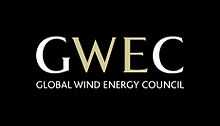Global Wind Energy Council
The Global Wind Energy Council (GWEC) was established in 2005 to provide a credible and representative forum for the entire wind energy sector at an international level. GWEC’s mission is to ensure that wind power establishes itself as the answer to today's energy challenges, providing substantial environmental and economic benefits.[1]

- GWEC's mandate from the members is to communicate the benefits of wind power - to national governments, policy makers and international institutions.
- GWEC provides authoritative research and analysis on the wind power industry in more than 70 countries around the world.
- GWEC works with governments to give them transparent information about the benefits and potential of wind power, enabling them to make informed decisions about national energy policies.
- GWEC supports collaboration between policy makers in different countries to help them share best practices and experiences in adding clean power to their energy mix.
What is GWEC
GWEC is a member-based organisation that represents the entire wind energy sector. The members of GWEC represent over 1,500 companies, organisations and institutions in more than 70 countries, including manufacturers, developers, component suppliers, research institutes, national wind and renewables associations, electricity providers, finance and insurance companies.
The members of GWEC are also all of the national wind industry trade associations, from both established and emerging markets, including the world largest markets of the United States, all the European markets, India and China.
GWEC works at the highest international political level to create a better policy environment for wind power. GWEC and its members are active all over the world, educating local and national governments and international agencies about the benefits of wind power.
Working with the UNFCCC, the IEA, international financial institutions, the IPCC and the International Renewable Energy Agency, GWEC represents the global wind industry to show how far we’ve come, but also to advocate new policies to help wind power reach its full potential in as wide a variety of markets as possible.
Global Wind Energy Council is funded by membership fees from our company and association members.
Global status overview
Global Wind Energy: Solid Growth in 2012
The Global Wind Energy Council's 2012 market statistics show continued expansion of the market, with annual market growth of almost 10%, and cumulative capacity growth of about 19%. A record year for US installations and a slower market in China mean that the two countries all but tied for the top spot in 2012.
“While China paused for breath, both the US and European markets had exceptionally strong years”, said Steve Sawyer, Secretary General of the Global Wind Energy Council. “Asia still led global markets, but with North America a close second, and Europe not far behind”.
Both the Chinese and Indian markets slowed somewhat in 2012, with their annual installations coming in at 13.2 and 2.3 GW respectively. Market consolidation and rationalisation in China, and a lapse in policy in India were the main reasons, but these conditions are expected to be short-lived, and Asian dominance of global wind markets is expected to continue.
In a last minute rush due to the anticipated expiration of the US’ Production Tax Credit at the end of December, the US industry installed more than 8,000 MW in the fourth quarter of 2012, ending up at 13,124 MW for the year, for all practical purposes tied with China. The “13th hour” extension of the tax credit means that although the US market will slow substantially in 2013, it is unlikely to be as much of a slowdown as was expected, and the nature of the extension bodes well for the 2013 market. Canada had a solid year, and Mexico more than doubled its installed capacity, installing 801 MW for a total of 1370 MW, joining the list of countries (now 24) with more than 1,000 MW of wind power capacity.
European markets, led by Germany and the UK, with surprising contributions from ‘emerging markets’ in Sweden, Romania, Italy and Poland, accounted for 12.4 GW last year, a new record . However, on-going sovereign debt crises mean that the outlook for the 2013 market is uncertain, although Europe’s framework legislation and its 2020 targets ensure a degree of stability. Europe also continued to lead offshore markets, with a 1,166 MW installed, more than 90% of total offshore installations of 1,293 MW in 2012.
Brazil led an otherwise relatively quiet Latin America market with 1,077 MW, to bring its total installed capacity to just over 2,500 MW, and Australia accounted for all of the new installations in the Pacific region, with 358 MW of new capacity in 2012 for a cumulative total of 2,584 MW.
The MENA region had another quiet year, with only one 50 MW project completed in Tunisia, but sub-Saharan Africa’s first large commercial wind farm came on line in 2012, a 52 MW project in Ethiopia. “This is just the beginning of the African market,”, said Sawyer, “and with construction started on 500+ MW in South Africa, we expect Africa to be a substantial new market, where clean, competitive energy generated with indigenous sources is a priority for economic development.”
Further information
Click here for detailed information on regional status in Asia, North America, Europe, Latin America, Pacific and Africa and Middle East.
Click here for detailed graphs & figures.
See also
- American Wind Energy Association
- Climate change
- Global warming
- List of large wind farms
- List of notable renewable energy organizations
- Wind power by country
References
External links
- Official website GWEC
- Global Wind Power Generated Record Year in 2006
- Global wind 2006 report
- GWEC Says Wind Boom will Continue
- Global Wind Energy
| ||||||||||||||||||||||||